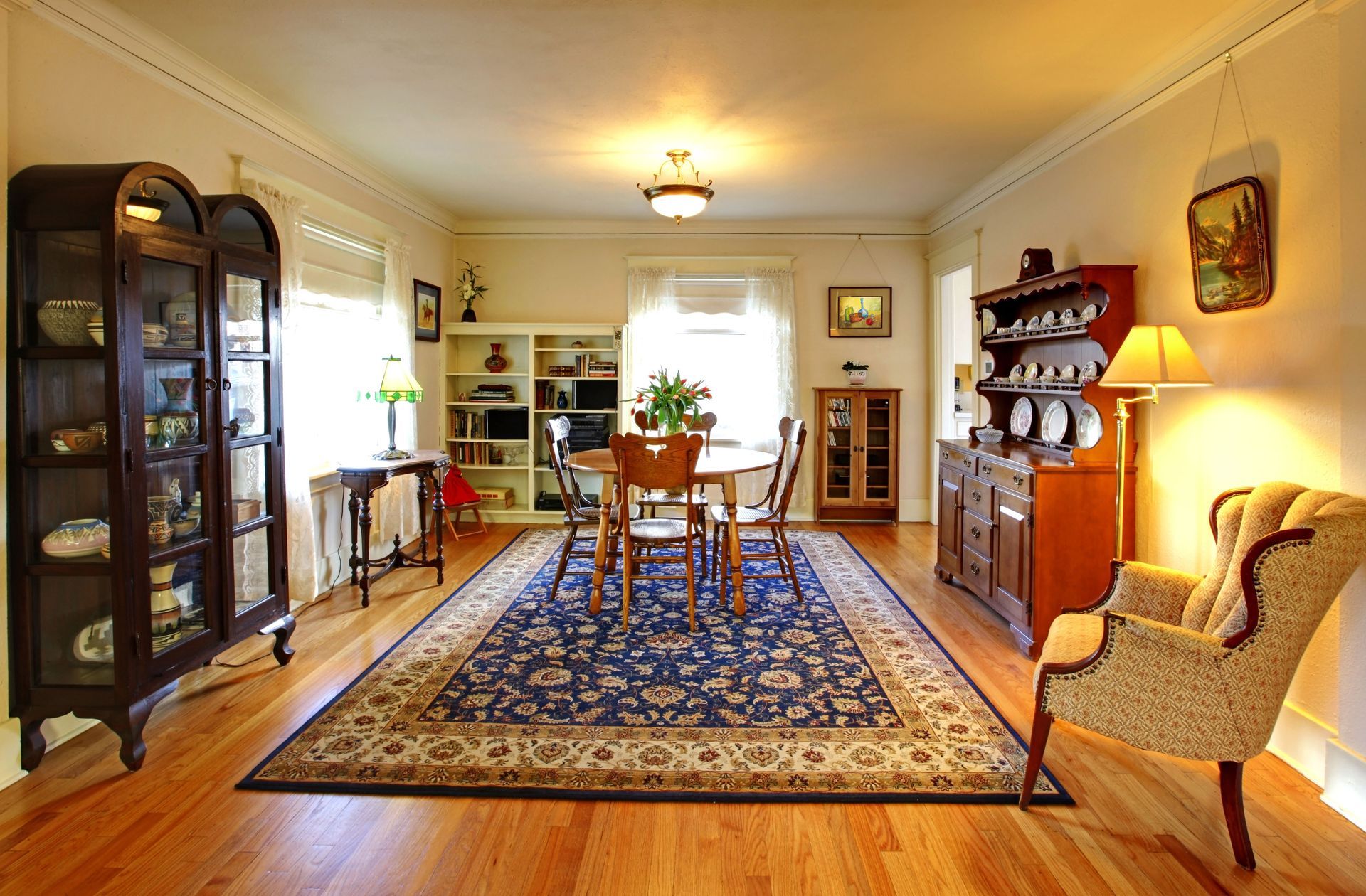September 12, 2025
Area rugs serve as a pivotal element in home decor, bringing together the aesthetics of a room while adding warmth and comfort. Choosing the perfect area rug involves more than just selecting a pleasant design; it requires a balance of style, practicality, and function that resonates with your living space. This guide delves into the essential factors to consider when choosing an area rug that not only enhances your home but also aligns with your personal taste, lifestyle, and financial considerations.
Assess Your Living Space
When selecting an area rug, the size and layout of the room are crucial factors. A well-chosen rug can anchor furniture, define boundaries, and even alter the perception of space within a room. Begin by measuring the dimensions of your room, paying attention to doorways and furniture placement to avoid overcrowding. The goal is to select a rug that complements the space without overwhelming it, so sometimes less is more. Additionally, consider traffic patterns and use rugs to direct movement naturally throughout the room.
The primary function of the room influences the type of area rug you should choose. For instance, a rug in a living room might need to be soft, comfortable, and yet durable, providing a cozy surface for children or pets, while in a dining room, durability and ease of cleaning may take precedence. Bedrooms often call for plush rugs for added comfort, especially during quieter, more intimate moments. Aligning your rug choice with the room's purpose ensures the space remains functional and inviting. Considering these priorities helps in focusing on practicality without compromising on style.
The existing decor in your living space plays a vital role in the selection of an area rug. It’s essential to consider the color scheme, design style, and materials already present. An area rug can serve as a focal point or a harmonious backdrop, depending on its harmony with the existing elements. Carefully match or contrast rug colors with wall paints, furniture upholstery, and decorative items for a cohesive look. This unification, or strategic contrast, ties the room together, enhancing the overall visual appeal.
Your personal style preferences should shine through in the choice of an area rug. Whether you lean towards modern minimalism, rustic charm, or eclectic exuberance, a rug can articulate your aesthetic vision. It's an opportunity to express your creativity and inject personality into a space. Consider textures, patterns, and colors that you naturally gravitate towards and imagine how they would integrate with your current setup. This approach ensures that your living space reflects your individuality and becomes a comfortable sanctuary.
Seasonal changes can influence the type of rugs that best suit your living space. Opting for warmer materials like wool in colder climates provides insulation, while lighter materials like cotton may be more appropriate for warmer seasons. Swapping rugs seasonally not only adjusts the ambiance to match the prevailing climate but also allows for fresh updates to your decor scheme. Being mindful of seasonal variations keeps the atmosphere adaptable, comfortable, and stylish throughout the year. This adaptability not only affects comfort but also enhances the longevity of your investment.
Explore Rug Material Options
Natural fibers such as wool, cotton, and jute are excellent choices for those seeking durability, comfort, and environmental friendliness. Wool is naturally stain-resistant and retains warmth, making it ideal for high-traffic areas or for those who prioritize sustainability. Jute and cotton offer a more casual appeal with their earthy textures, often available in a variety of weaves and patterns. These materials are biodegradable and renewable, thus appealing to eco-conscious consumers. Their organic nature ensures they provide not only aesthetic value but also contribute to a healthier indoor environment.
Synthetic fibers like polypropylene, nylon, and polyester offer affordable options that blend style with functionality. These fibers are renowned for their resistance to fading, staining, and moisture, making them an attractive choice for families or pet owners. Although they might not have the luxurious feel of natural fibers, they compensate with resilience and an extensive range of designs and colors. Synthetics often mimic the look of natural materials at a fraction of the cost. This affordability doesn't compromise quality, making synthetics a smart buy for budget-conscious decorators.
The durability of an area rug depends largely on its material and construction. High-traffic areas demand robust materials that can withstand wear and tear while still looking fresh and inviting. Consider how easy the rug is to clean; some materials require specialized cleaning techniques that might not be practical for your lifestyle. Regular maintenance enhances the longevity of a rug, making it a sound investment. Choosing a durable area rug ensures it remains a vibrant part of your decor for years, offering excellent value and return on your investment.
Those with allergies or sensitivities must take extra caution when selecting rug materials. Some fibers, especially synthetics, may provoke allergic reactions. Natural fibers like wool are hypoallergenic, making them suitable for individuals prone to allergies. However, it's important to keep rugs clean and free of dust to avoid exacerbating sensitivities. When selecting a rug, consider materials treated to resist dust mites and allergens. Prioritizing health alongside aesthetics leads to more harmonious and comfortable living spaces.
Balancing quality and budget is key when selecting a rug material. Naturally, rugs crafted from premium materials such as silk and hand-knotted wool will be priced higher, reflecting their craftsmanship and quality. On the other hand, synthetic materials offer cost-effective solutions without drastically sacrificing style. According to Grand View Research, the area rugs market size was estimated at over $11 billion globally in 2023. This trend underscores the diverse range of options available, catering to varied budgets and preferences.
Determine the Ideal Size and Placement
Standard rug sizes provide a convenient starting point for selecting a rug that fits various rooms and configurations. From our experience, rugs typically come in standard sizes such as 5'x8', 8'x10', and 9'x12', suitable for most living rooms, bedrooms, and dining areas. Each size brings a unique balance and is chosen based on the specific dimensions and purpose of the space it occupies. When selecting a rug, focus on how these standard sizes will fit into your intended layout. Proper sizing enhances cohesion and elevates the room’s aesthetic appeal.
The visual balance of a room can be significantly influenced by the proportion of the area rug within it. A well-proportioned area rug creates a sense of harmony by tying together disparate elements and defining distinct areas within a room. To achieve this balance, ensure the rug dimensions provide adequate perimeter space from wall edges and appropriately align with seating and furniture. Proportion plays a pivotal role in ensuring the room feels neither cramped nor oversized. Striking the right visual balance maximizes both the aesthetic and functionality of the space.
Scaling a rug to suit large and small spaces involves understanding their unique characteristics. For expansive areas, larger rugs ground the room and prevent the furniture from appearing to float. Contrarily, smaller spaces benefit from the unity a well-scaled rug offers, often resulting in a more cohesive and charming ambiance. Use visual tricks, like horizontal lines, to expand the perceived space and enhance flow. Adjusting scale thoughtfully enhances room transitions and maintains a sense of proportion. This approach ensures each space feels appropriately finished and comfortable.
The placement of rugs in relation to furniture contributes significantly to the room’s layout and comfort. A full furniture placement, where all furniture sits entirely on the rug, offers a unified look. Alternatively, partial placements, where some furniture legs sit on the rug, can delineate living areas within larger spaces. Understanding these placements is crucial for flagging traffic flows and ensuring both safety and aesthetics. Proper area rug positioning also prevents wear on the flooring and adds a dimension of warmth and comfort. This strategic thinking results in a more practical and visually appealing environment.
Custom-sized rugs offer flexibility for unique spaces, ensuring a tailored fit for non-standard room dimensions. When rooms or furnishing configurations don't align with standard sizes, custom rugs provide an opportunity to achieve the perfect balance between functionality and style. This option allows homeowners to maintain their design vision and ensure every aspect of the room is cohesive. Custom sizing can also be a solution for rooms with architectural elements, like fireplaces or unusual nooks. Opting for this level of personalization adds a bespoke touch to your home decor.
Selecting the perfect area rug involves a comprehensive analysis of personal style, living space, material preference, and budget. This decision-making process is vital in transforming your room's function and beauty, serving both aesthetic and practical needs. By applying these considerations thoughtfully, you ensure that your selection won't only enhance your living space but also serve as a testament to your personal style and foresight. A well-chosen area rug is more than a decorative addition—it's a centerpiece that ties the room together in harmony and comfort. Reach out to Miller Carpets to learn more today!








